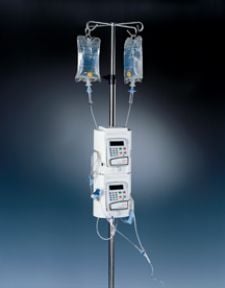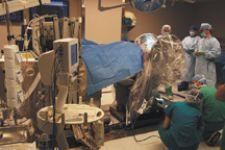
Medrad's Continuum MR Compatible Infusion System is the first infusion system compatible with the magnetic resonance environment.
Utilizing strong magnetic fields and radio waves, magnetic resonance imaging (MRI) yields detailed images of soft tissue, including the brain, spine, vasculature and joints. From orthopedics to cardiology, MRI is proving itself a frontrunner in the diagnosis and treatment planning of an increasing number of disease states. And in the operating suite, the technology is reaping huge benefits for surgeons – particularly neurosurgeons.
Real-Time Imaging in the OR
Intraoperative navigation has been around since the mid 1990s and relies on the collective synergies of the surgeon, radiologist and anesthesiologist. While technologies such as CT, MRI, PET and SPECT and ultrasound can be utilized, neurosurgeons are particularly fond of MRI because it allows them to plan their surgeries in detail, and also provides them with the improved visibility and confirmation required during delicate surgeries.
“MRI provides the surgeon with exquisite anatomic detail,” explained Sergio Bergese, M.D, associate professor, director of Neuroanesthesia, Departments of Anesthesiology and Neurological Surgery, The Ohio State University. “It helps them to prepare a more detailed plan for surgery, and eliminates the guesswork when operating on a tumor.”
Despite what it implies, intraoperative MRI does not involve scanning the patient while the surgeon is operating. Especially suited for intrinsic brain tumors, the patient is scanned before surgery, thus allowing the surgeon to plan his surgical route, says Dr. Bergese. Then, before closing the cranium, the low-field MRI (Ohio State uses the Polestar N-20 0.2T from Medtronic) is placed next to the patient’s head and another image is taken. This digital snapshot helps determine if more tumor needs to be removed or if it is safe to stop, and by doing so, save normal tissue from further resection.
Safety First
Unfortunately, intraoperative MRI does come with a caveat. Because of the strong magnetic field, only non-ferromagnetic technology can be used in the intraoperative MRI suite.
That means in order for narcotics to be administered during surgery, or for example, to control a patient’s high blood pressure, a MRI-compatible infusion system must be available.
“Every single neurosurgery patient requires intravenous drips, on the average, three to four drips,” Dr. Bergese said. “When administering general anesthesia, you don’t want the brain getting too much or too little blood,” he explained.
Dr. Bergese and Ohio State currently use Medrad’s Continuum MRI-compatible infusion system during intraoperative MRI procedures. Initially developed for use in the dedicated MRI suite, the Continuum allows for continuous patient sedation during an MRI exam. Recognizing the technology’s unique benefits, neurosurgeons are now utilizing the infusion system with lower field MRI units in the OR.
Introduced in 2002, the Continuum is the first MR-compatible infusion system capable of meeting the need for safe and reliable infusion of critical medications during MRI procedures. FDA cleared initially for use on 1.5T systems, the Continuum can now also be used during MRI procedures in strengths up to 3.0T. According to Medrad, ongoing tests on attraction, homogeneity, artifact and static magnetic field ensure that the system meets or exceeds necessary safety and non-interference requirements. Recent enhancements to the technology include greater selection of drug-specific units of measurement, which increases the number of drugs that can be infused. In addition, by reducing the confusion associated with manual conversion, the Continuum also helps prevent programming errors. Furthermore, use of Medrad’s Veris Continuum kit, which combines the Continuum with the Veris MR monitor, allows for comprehensive physiological patient monitoring along with continuous infusion therapy.
Having used the Continuum for the last two years, Dr. Bergese is very pleased with the unit, explaining that the pumps are small, portable, easy to maneuver and above all, very reliable. In fact, on a scale from 0-10, Dr. Bergese rates the Continuum an impressive eight.
“The Continuum,” Dr. Bergese stated simply, “does more than enhance intraoperative MRI — it allows for better patient care in the intraoperative MRI suite.”



